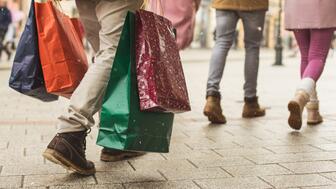The couple pleaded guilty to concealing at least $127 million in cash transactions at its precious metals businesses.
The Malaise of Macy’s
One of Macy’s biggest problems has been its inability to convert Kaufmann’s shoppers, Editor-in-Chief (and Western Pennsylvania native) Michelle Graff writes.

I started this blog on Friday after reading numerous reports about the possible sale of Macy’s.
Since then, there has been other major news that’s broken in the retail world.
On Sunday, Tiffany & Co. announced that CEO Frederic Cumenal was stepping down and would be temporarily replaced by Chairman and former CEO Michael Kowalski while the jeweler hunts for a permanent leader.
Though some news outlets seemed shocked by the news, I wasn’t.
The retailer’s sales have been, to coin Kowalski, disappointing. Worldwide net sales rose 1 percent, declined 6 percent and 7 percent in the last three quarters, and Tiffany has posted poor holiday performances back-to-back.
I don’t think it’s hard to understand why Cumenal no longer has the corner office, or why another big jewelry retailer, Signet Jewelers Ltd., also recently changed up its senior management after its holiday season was less than stellar.
Retail is changing and retailers--particularly public companies that have to answer to shareholders--have to change with it.
So, while I may return to the topics of Signet and/or Tiffany at a later date, for now I want to talk about Macy’s, Retail Dive and an interesting conversation I recently had with my mother.
While reading multiple stories about the murky future of Macy’s on Friday, I came across this excellent analysis from RetailDive.com.
In her article, Contributing Editor Daphne Howland argues that what’s killing Macy’s isn’t competition from Amazon or off-price outlets but, rather, Federated Department Stores’ (which later changed its name to Macy’s) 2005 purchase of The May Company.
The acquisition left the retailer over-stored and unable to offer exactly what customers want in every market.
Federated/Macy’s bought up “thriving” regional chains--like Kaufmann’s in Western Pennsylvania, a retail staple of my youth--with roots in their respective communities and made them “cogs in a machine,” the articles states.
The story struck a chord with me because of a recent conversation I had with my mother, in which we got to talking about the state of retail where I grew up, in Beaver County, Pennsylvania.
Mom was telling me how she’d read in the local newspaper (long live print journalism!) that the Macy’s store in the Beaver Valley Mall--which I made famous via this blog before--was one of the many Macy’s that closed at the end of last year.
She wasn’t surprised to read that Macy’s was shutting down because it
To my mom, the store went downhill after it was converted from Kaufmann’s into Macy’s; she never saw much in there that she wanted to buy and the store itself wasn’t as nice either.
And, Mom said, a lot of other people in the area felt the same way.
Kaufmann’s had deep local roots.
Founded by 1871 by Jacob and Isaac Kaufmann, the department store was part of the fabric of Western Pennsylvania for decades. There’s the iconic clock in downtown Pittsburgh (“Meet me under the Kaufmann’s clock.”) and Fallingwater, the amazing Frank Lloyd Wright-designed weekend home the Kaufmann family had built in Mill Run, Pennsylvania, a must-see if you ever get to the area.
There really wasn’t any way for Macy’s to emulate that and, as a result, what ended up happening is exactly what my mom observed: People really never came to love Macy’s the way they loved Kaufmann’s.
My mom’s musings on Macy’s sum up perfectly the point that was made in the Retail Dive article.
The retailer got too big to deliver any kind of personalized experience to customers, to stock each store with merchandise that suited them and to make area residents feel that Macy’s knew what they liked.
And, it seems, this lack of personalization was especially detrimental to Macy’s in Midwest metropolitan regions like Pittsburgh, as this is where Macy’s is expected to close the most stores, according to Retail Dive.
Retail today is so different and so difficult that I cannot offer jewelers a panacea, a single solution for all their store’s problems. I cannot say that being a town’s “local jeweler” will save a store because, as we’ve seen, longtime family-owned retailers are closing down too.
And I cannot say that remaining a Kaufmann’s would have saved this specific store, given the long, slow economic decline of the area surrounding it and the myriad challenges facing brick-and-mortar retailers today, particularly those situated in aging malls.
But I think what can be learned from Macy’s is that for retailers, local/regional names do carry weight among area residents and aren’t necessarily so easily replaced.
As National Jeweler columnist Peter Smith stated when commenting on this story about San Francisco retailer Shreve & Co. closing the Portland, Oregon storeit opened in the space once occupied by 88-year-old store Carl Greve Jewelers: “I wonder if things would have been different if they had kept the Carl Greve name? Shreve’s had no awareness in that market. Sad to see.”
There is value in having a connection to the community and in knowing exactly what your customers want.
The Latest

Consumers shared concerns about prices, inflation, tariffs, trade, and politics in the survey’s write-in response section.

In February 2026, the auction house will move its headquarters to the former Steinway Hall, a neoclassical landmark on Billionaires’ Row.

How Jewelers of America’s 20 Under 40 are leading to ensure a brighter future for the jewelry industry.

The new show will take place Jan. 23-25, 2026.


The former BHP Billiton leader and Gemfields chairman is remembered for his influential leadership throughout his 50-year mining career.

The LVMH-owned brand has partnered with the costume design union to revamp its award for 2026.

Roseco’s 704-page catalog showcases new lab-grown diamonds, findings, tools & more—available in print or interactive digital editions.

The luxury titan inked a deal to acquire an initial minority stake in the jewelry manufacturer with a pathway to full ownership by 2032.

The company’s curation of unsigned vintage and estate jewelry debuted at the Bloomingdale’s in Costa Mesa, California.

In the recent multi-shipment seizure, CBP also found counterfeit Audemars Piguet, Moncler, and Chrome Hearts items.

Jewelers of America execs and National Jeweler editors discuss tariffs, the sky-high gold price, and the engagement that broke the internet.

The luxury goods company said founder Ippolita Rostagno will remain at the brand’s helm.

Laura Burdese, who joined the Italian luxury brand in 2022, will take on the role in July.

Need a gift for the cat lover who has everything? Look no further than our latest Piece of the Week.

It purchased the “Grosse Pièce,” an ultra-complicated Audemars Piguet pocket watch from the ‘20s, for a record-breaking price at Sotheby’s.

The lab-grown diamond grower now offers custom engagement and fashion jewelry through its Kira Custom Lab Jewelry service.

Chandler got his start at Michelson Jewelers and has served as DCA president and CEO since 2001. He will retire at the end of the month.

The boutique is slated to open this week inside Terminal 8, offering pre-owned Rolex watches and more to international travelers.

Sponsored by Digital Monitoring Products

The special-edition egg pendant ingested in a New Zealand jewelry store was recovered after a six-day wait.

Associate Editor Natalie Francisco plays favorites with Piece of the Week, selecting a standout piece of jewelry from each month of 2025.

The “Love and Desire” campaign is inspired by the magic that follows when one’s heart leads the way, said the brand.

Two awardees will receive free tuition for an educational course at the Swiss lab, with flights and lodging included.

Berta de Pablos-Barbier will replace Alexander Lacik at the start of January, two months earlier than expected.

Sotheby’s held its first two jewelry sales at the Breuer building last week, and they totaled nearly $44 million.

Winners will receive free registration and lodging for its fourth annual event in Detroit.


























